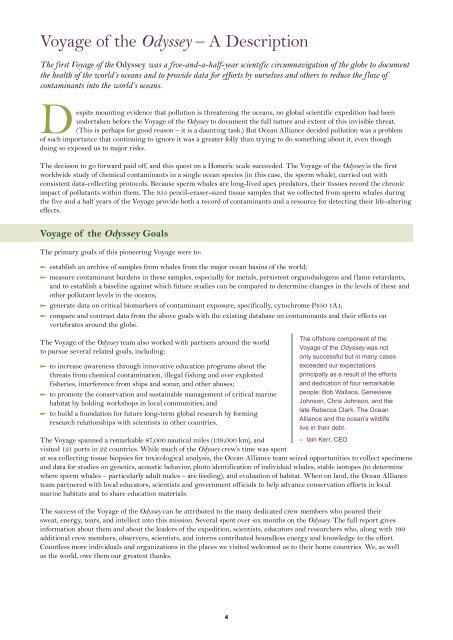Voyage of the Odyssey executive summary - Ocean Alliance
Voyage of the Odyssey executive summary - Ocean Alliance
Voyage of the Odyssey executive summary - Ocean Alliance
You also want an ePaper? Increase the reach of your titles
YUMPU automatically turns print PDFs into web optimized ePapers that Google loves.
<strong>Voyage</strong> <strong>of</strong> <strong>the</strong> <strong>Odyssey</strong> – A Description<br />
The first <strong>Voyage</strong> <strong>of</strong> <strong>the</strong> <strong>Odyssey</strong> was a five-and-a-half-year scientific circumnavigation <strong>of</strong> <strong>the</strong> globe to document<br />
<strong>the</strong> health <strong>of</strong> <strong>the</strong> world’s oceans and to provide data for efforts by ourselves and o<strong>the</strong>rs to reduce <strong>the</strong> flow <strong>of</strong><br />
contaminants into <strong>the</strong> world’s oceans.<br />
Despite mounting evidence that pollution is threatening <strong>the</strong> oceans, no global scientific expedition had been<br />
undertaken before <strong>the</strong> <strong>Voyage</strong> <strong>of</strong> <strong>the</strong> <strong>Odyssey</strong> to document <strong>the</strong> full nature and extent <strong>of</strong> this invisible threat.<br />
(This is perhaps for good reason – it is a daunting task.) But <strong>Ocean</strong> <strong>Alliance</strong> decided pollution was a problem<br />
<strong>of</strong> such importance that continuing to ignore it was a greater folly than trying to do something about it, even though<br />
doing so exposed us to major risks.<br />
The decision to go forward paid <strong>of</strong>f, and this quest on a Homeric scale succeeded. The <strong>Voyage</strong> <strong>of</strong> <strong>the</strong> <strong>Odyssey</strong> is <strong>the</strong> first<br />
worldwide study <strong>of</strong> chemical contaminants in a single ocean species (in this case, <strong>the</strong> sperm whale), carried out with<br />
consistent data-collecting protocols. Because sperm whales are long-lived apex predators, <strong>the</strong>ir tissues record <strong>the</strong> chronic<br />
impact <strong>of</strong> pollutants within <strong>the</strong>m. The 955 pencil-eraser-sized tissue samples that we collected from sperm whales during<br />
<strong>the</strong> five and a half years <strong>of</strong> <strong>the</strong> <strong>Voyage</strong> provide both a record <strong>of</strong> contaminants and a resource for detecting <strong>the</strong>ir life-altering<br />
effects.<br />
<strong>Voyage</strong> <strong>of</strong> <strong>the</strong> <strong>Odyssey</strong> Goals<br />
The primary goals <strong>of</strong> this pioneering <strong>Voyage</strong> were to:<br />
l establish an archive <strong>of</strong> samples from whales from <strong>the</strong> major ocean basins <strong>of</strong> <strong>the</strong> world;<br />
l measure contaminant burdens in <strong>the</strong>se samples, especially for metals, persistent organohalogens and flame retardants,<br />
and to establish a baseline against which future studies can be compared to determine changes in <strong>the</strong> levels <strong>of</strong> <strong>the</strong>se and<br />
o<strong>the</strong>r pollutant levels in <strong>the</strong> oceans;<br />
l generate data on critical biomarkers <strong>of</strong> contaminant exposure, specifically, cytochrome P450 1A1;<br />
l compare and contrast data from <strong>the</strong> above goals with <strong>the</strong> existing database on contaminants and <strong>the</strong>ir effects on<br />
vertebrates around <strong>the</strong> globe.<br />
The <strong>Voyage</strong> <strong>of</strong> <strong>the</strong> <strong>Odyssey</strong> team also worked with partners around <strong>the</strong> world<br />
to pursue several related goals, including:<br />
l to increase awareness through innovative education programs about <strong>the</strong><br />
threats from chemical contamination, illegal fishing and over exploited<br />
fisheries, interference from ships and sonar, and o<strong>the</strong>r abuses;<br />
l to promote <strong>the</strong> conservation and sustainable management <strong>of</strong> critical marine<br />
habitat by holding workshops in local communities; and<br />
l to build a foundation for future long-term global research by forming<br />
research relationships with scientists in o<strong>the</strong>r countries.<br />
The <strong>Voyage</strong> spanned a remarkable 87,000 nautical miles (139,000 km), and<br />
– Iain Kerr, CEO<br />
visited 121 ports in 22 countries. While much <strong>of</strong> <strong>the</strong> <strong>Odyssey</strong> crew’s time was spent<br />
at sea collecting tissue biopsies for toxicological analysis, <strong>the</strong> <strong>Ocean</strong> <strong>Alliance</strong> team seized opportunities to collect specimens<br />
and data for studies on genetics, acoustic behavior, photo identification <strong>of</strong> individual whales, stable isotopes (to determine<br />
where sperm whales – particularly adult males – are feeding), and evaluation <strong>of</strong> habitat. When on land, <strong>the</strong> <strong>Ocean</strong> <strong>Alliance</strong><br />
team partnered with local educators, scientists and government <strong>of</strong>ficials to help advance conservation efforts in local<br />
marine habitats and to share education materials.<br />
The success <strong>of</strong> <strong>the</strong> <strong>Voyage</strong> <strong>of</strong> <strong>the</strong> <strong>Odyssey</strong> can be attributed to <strong>the</strong> many dedicated crew members who poured <strong>the</strong>ir<br />
sweat, energy, tears, and intellect into this mission. Several spent over six months on <strong>the</strong> <strong>Odyssey</strong>. The full report gives<br />
information about <strong>the</strong>m and about <strong>the</strong> leaders <strong>of</strong> <strong>the</strong> expedition, scientists, educators and researchers who, along with 190<br />
additional crew members, observers, scientists, and interns contributed boundless energy and knowledge to <strong>the</strong> effort.<br />
Countless more individuals and organizations in <strong>the</strong> places we visited welcomed us to <strong>the</strong>ir home countries. We, as well<br />
as <strong>the</strong> world, owe <strong>the</strong>m our greatest thanks.<br />
4<br />
The <strong>of</strong>fshore component <strong>of</strong> <strong>the</strong><br />
<strong>Voyage</strong> <strong>of</strong> <strong>the</strong> <strong>Odyssey</strong> was not<br />
only successful but in many cases<br />
exceeded our expectations<br />
principally as a result <strong>of</strong> <strong>the</strong> efforts<br />
and dedication <strong>of</strong> four remarkable<br />
people: Bob Wallace, Genevieve<br />
Johnson, Chris Johnson, and <strong>the</strong><br />
late Rebecca Clark. The <strong>Ocean</strong><br />
<strong>Alliance</strong> and <strong>the</strong> ocean’s wildlife<br />
live in <strong>the</strong>ir debt.


